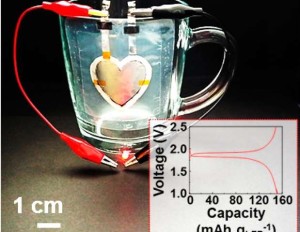
The batteries have the ability to be integrated into the surface of the objects, making it seem like seem like there is no battery at all.
A new development out of the Ulsan National Institute of Science and Technology (UNIST) has yielded a new technique that could make it possible to print batteries on any surface.
With recent interests in flexible electronics—such as bendable screen displays—researchers globally have been investing research efforts into developing printable functional materials for both electronic and energy applications. With this, many researchers predict the future of the li-ion battery as one with far less size and shape restrictions, having the ability to be printed in its entirety anywhere.
The research team from UNIST, led by ECS member Sang-Young Lee, is setting that prediction on the track to reality. Their new paper published in the journal Nano Letters details the printable li-ion battery that can exist on almost any surface.
The typical manufacturing of li-ion batteries restricts the development of varying sizes and shapes. However, the new battery does not require many of the same manufacturing methods as the traditional li-ion. Instead, the electrolyte is made of a paste and the electrodes of a slurry, which can be printed on to nearly any surface.
“All battery components, such as cathodes, anodes and electrolytes, can be printed on arbitrary objects of complex geometries, thereby enabling the seamless integration of shape-conformable solid-state rechargeable batteries with various form factors into complex-shaped (such as curvilinear) objects,” Lee told Phys.org. “We envision that the printable battery presented herein holds a great deal of promise for potential use in forthcoming wearable electronics and IOTs (Internet of Things), which eventually removes pre-designated battery space with fixed dimension and shape.”
To demonstrate the practicality of their work, the researcher sprinted a heart-shaped battery on a cup and another simple square battery on a pair of glasses set to replicate the application to technologies such as Google Glasses.
This from Phys.org:
Overall, the printed battery performance is competitive with that of other flexible batteries, demonstrating good long-term storage capacity, 90% capacity retention after 30 cycles, and no detectable change in electrical resistance during repeated bending cycles. Still, in the future the researchers plan to improve certain areas, including increasing the energy density and prolonging the battery life.
“To extend application fields of the printable batteries, we are currently considering a wide variety of printing techniques,” Lee said. “Ink-jet and 3D printing can be recommended as a promising technology to enable the facile fabrication of multidimensional/multiscale complex-structured power sources. An urgent prerequisite to achieve this goal is that printable battery components should be precisely tuned to fulfill the rheological requirements of each printing technology, without impairing electrochemical properties. Our group has recently achieved some intriguing results on printable batteries with ink-jet and 3D printing technology, which will provide completely new application fields of rechargeable power sources that we have not yet encountered.”
PS: Check out our JSS focus issue, Printable Functional Materials for Electronics and Energy Applications. All article are entirely free!
And make sure to submit your papers for our upcoming focus issues!


